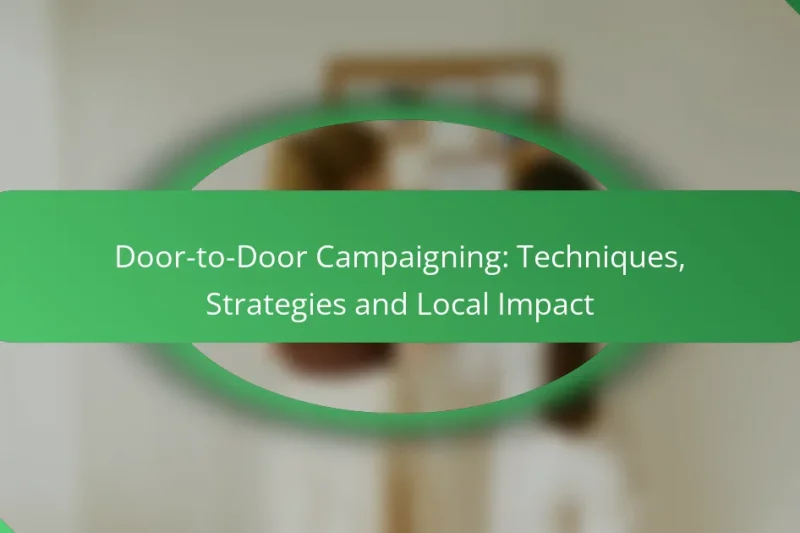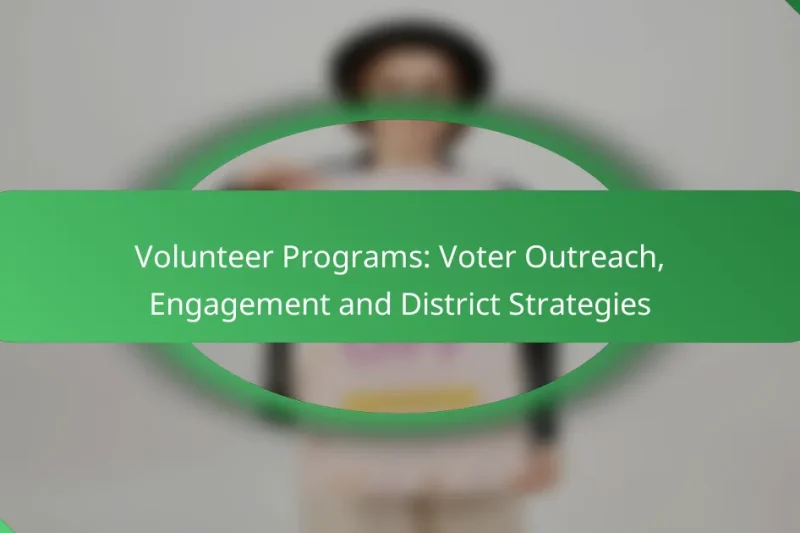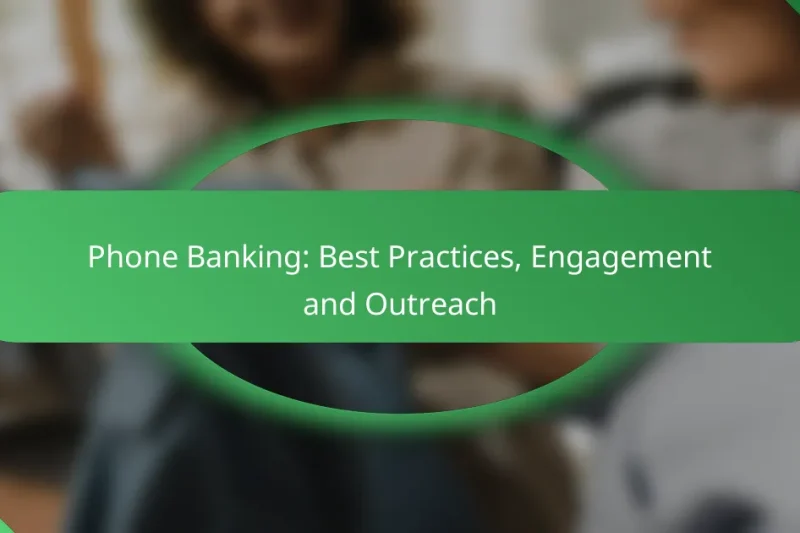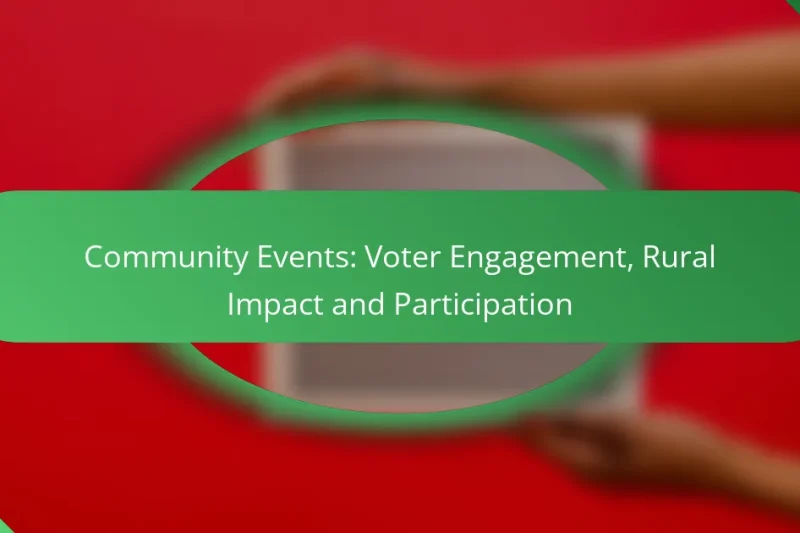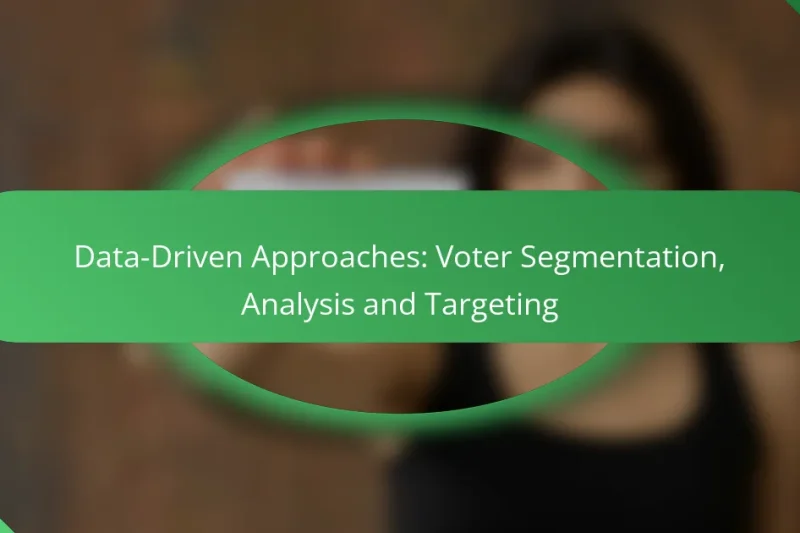Door-to-door campaigning is a powerful tool for building community connections and fostering engagement through personalized interactions. … Door-to-Door Campaigning: Techniques, Strategies and Local ImpactRead more
Voter Outreach Strategies for Success
Voter outreach strategies play a crucial role in enhancing participation in elections by fostering personal connections with potential voters. By leveraging technology and direct engagement methods, organizations can effectively increase voter registration and turnout while ensuring individuals feel informed and empowered about the voting process.
Volunteer Programs: Voter Outreach, Engagement and District Strategies
Volunteer programs play a crucial role in enhancing voter outreach and engagement by mobilizing community members … Volunteer Programs: Voter Outreach, Engagement and District StrategiesRead more
Phone Banking: Best Practices, Engagement and Outreach
Phone banking is a powerful tool for enhancing customer engagement through direct and personalized communication. By … Phone Banking: Best Practices, Engagement and OutreachRead more
Community Events: Voter Engagement, Rural Impact and Participation
Community events play a vital role in boosting voter engagement, particularly in rural areas, by creating … Community Events: Voter Engagement, Rural Impact and ParticipationRead more
Text Messaging Campaigns: Mobilization, Reach and Effectiveness
Text messaging campaigns play a crucial role in mobilization by enabling direct and immediate communication with … Text Messaging Campaigns: Mobilization, Reach and EffectivenessRead more
Data-Driven Approaches: Voter Segmentation, Analysis and Targeting
Data-driven approaches to voter segmentation, analysis, and targeting are transforming political campaigns by enabling organizations to … Data-Driven Approaches: Voter Segmentation, Analysis and TargetingRead more
Outreach Strategies: Evaluation, Impact and Voter Turnout
Outreach strategies play a crucial role in enhancing voter turnout by engaging citizens through various methods … Outreach Strategies: Evaluation, Impact and Voter TurnoutRead more
What are effective voter outreach strategies in the United States?
Effective voter outreach strategies in the United States include direct engagement methods that connect with potential voters on a personal level. These strategies aim to increase voter registration and turnout by building relationships and providing essential information about the voting process.
Door-to-door canvassing
Door-to-door canvassing involves volunteers visiting homes to engage with residents directly. This method allows for personal conversations, where canvassers can answer questions, dispel myths, and encourage voter registration.
To maximize effectiveness, canvassers should be well-trained and equipped with materials that highlight key issues and voting information. Setting clear goals for each canvassing session can help measure success and improve future efforts.
Phone banking
Phone banking is another effective outreach strategy where volunteers make calls to potential voters. This method can be particularly useful for reaching individuals who may not be home during canvassing hours.
When conducting phone banking, it’s essential to have a script that is friendly yet informative. Volunteers should be prepared to handle questions and concerns, and follow-up calls can reinforce the message and encourage voter participation.
Social media campaigns
Social media campaigns leverage platforms like Facebook, Twitter, and Instagram to reach a broad audience quickly. These campaigns can share information about registration deadlines, polling locations, and key issues relevant to voters.
To create an impactful social media presence, organizations should use engaging visuals and clear messaging. Regular updates and interactive content, such as polls or Q&A sessions, can help maintain interest and encourage sharing among users.
Email outreach
Email outreach involves sending targeted messages to potential voters to inform them about the election process and motivate them to vote. This strategy allows for personalized communication and can be highly effective when tailored to specific demographics.
To enhance engagement, emails should include compelling subject lines and clear calls to action. Segmenting the email list based on interests or past voting behavior can improve response rates and ensure the content resonates with recipients.
Community events
Hosting community events provides an opportunity for direct interaction with voters in a relaxed setting. These events can include town halls, voter registration drives, or informational sessions about the voting process.
When planning community events, consider partnering with local organizations to increase attendance and outreach. Providing food, entertainment, or incentives can also attract more participants and create a welcoming atmosphere for discussions about voting.
How can technology enhance voter outreach?
Technology can significantly enhance voter outreach by streamlining communication and targeting efforts more effectively. By utilizing various digital tools, organizations can engage voters, analyze data, and automate messaging to increase participation in elections.
Voter engagement apps
Voter engagement apps serve as platforms for educating and mobilizing voters. These applications often provide information on registration, polling locations, and upcoming elections, making it easier for users to stay informed.
When selecting a voter engagement app, consider features such as user-friendliness, accessibility, and integration with social media. Popular examples include Vote.org and BallotReady, which help users navigate the voting process efficiently.
Data analytics for targeting
Data analytics allows organizations to identify and target specific voter demographics effectively. By analyzing past voting behavior, demographic information, and engagement patterns, campaigns can tailor their outreach strategies to resonate with particular groups.
Utilizing tools like voter databases and analytics platforms can help campaigns refine their messaging and allocate resources more effectively. For instance, focusing on swing districts or underrepresented communities can yield higher engagement rates.
Automated messaging systems
Automated messaging systems facilitate timely communication with voters through text messages, emails, or social media. These systems can be programmed to send reminders about registration deadlines, polling dates, and other critical information.
To maximize effectiveness, ensure that messages are concise and personalized. Avoid overwhelming voters with excessive communication, and consider segmenting your audience to tailor messages based on their interests or previous interactions.
What are the best practices for voter engagement?
The best practices for voter engagement focus on creating meaningful connections with potential voters and ensuring they feel informed and empowered. Effective strategies include personalized communication, building trust through transparency, and utilizing local influencers to amplify outreach efforts.
Personalized communication
Personalized communication involves tailoring messages to individual voters based on their demographics, interests, and previous interactions. This approach can significantly increase engagement rates, as voters are more likely to respond to messages that resonate with their specific concerns.
Utilize data from past elections or surveys to segment your audience and craft targeted messages. For example, sending reminders about voting dates or polling locations can be more effective when they are customized to reflect the recipient’s neighborhood or community issues.
Building trust through transparency
Building trust through transparency is essential for fostering a positive relationship with voters. Being open about campaign goals, funding sources, and decision-making processes can help alleviate skepticism and encourage voter participation.
Share regular updates on campaign activities and be honest about challenges. For instance, hosting town hall meetings where voters can ask questions and express concerns can enhance credibility and strengthen community ties.
Utilizing local influencers
Utilizing local influencers can amplify voter outreach efforts by leveraging their established credibility and connection with the community. Influencers can include local leaders, activists, or even popular figures who resonate with the target demographic.
Collaborate with these influencers to spread your message through social media, community events, or public endorsements. This strategy can help reach a broader audience and encourage voter turnout, especially among younger demographics who may be more influenced by peer recommendations.
What metrics should be used to measure outreach success?
To effectively measure outreach success, focus on key metrics that reflect voter engagement and participation. These metrics include voter turnout rates, engagement levels on social media, and response rates from outreach efforts.
Voter turnout rates
Voter turnout rates indicate the percentage of eligible voters who actually cast their ballots during an election. Tracking these rates helps assess the effectiveness of outreach strategies in mobilizing voters. For instance, a turnout increase of a few percentage points can signify successful engagement efforts.
Consider comparing turnout rates across different demographics or regions to identify which groups are responding well to outreach. This can help tailor future strategies to improve participation among underrepresented populations.
Engagement levels on social media
Engagement levels on social media reflect how actively voters interact with campaign content. Metrics such as likes, shares, comments, and overall reach provide insight into the effectiveness of messaging and outreach. High engagement often correlates with increased awareness and interest in voting.
Utilize tools to monitor engagement trends over time, and adjust content strategies based on what resonates with your audience. For example, if video content generates more interaction than static posts, prioritize video in your outreach efforts.
Response rates from outreach efforts
Response rates from outreach efforts measure how many individuals engage with direct communications, such as emails, phone calls, or text messages. A higher response rate indicates that your outreach is effectively reaching and resonating with voters. Aim for response rates in the low to mid-teens as a benchmark for success.
To improve response rates, personalize outreach messages and ensure they are clear and actionable. Avoid generic communications, as tailored messages tend to yield better engagement and can lead to increased voter participation.
What are the challenges in voter outreach?
Voter outreach faces several significant challenges that can hinder effective engagement. Key issues include voter apathy, limited resources, and the spread of miscommunication and misinformation, all of which can reduce participation in elections.
Voter apathy
Voter apathy refers to the lack of interest or motivation among eligible voters to participate in elections. This can stem from feelings of disenfranchisement, disillusionment with the political process, or a belief that their vote does not matter. To combat apathy, outreach efforts should focus on educating voters about the impact of their participation and the importance of their voice in shaping policies.
Engaging voters through relatable messaging and community involvement can help rekindle interest. For example, local events that highlight the significance of voting can create a sense of urgency and connection to the electoral process.
Limited resources
Limited resources, including budget constraints and staffing shortages, can severely restrict voter outreach initiatives. Organizations often struggle to allocate sufficient funds for advertising, events, and volunteer training. Prioritizing outreach efforts based on target demographics and utilizing cost-effective digital platforms can maximize impact.
Collaborating with local community groups or leveraging social media can extend outreach without significant financial investment. Developing partnerships can also help share resources and broaden the reach of voter engagement efforts.
Miscommunication and misinformation
Miscommunication and misinformation can create confusion among voters regarding the voting process, deadlines, and requirements. This often leads to decreased turnout as individuals may feel uncertain about their eligibility or the steps needed to vote. Clear, consistent messaging is essential to counteract these issues.
Utilizing multiple channels, such as social media, community meetings, and local media, can help ensure accurate information reaches a wide audience. Providing easily accessible resources, such as FAQs or guides, can also clarify the voting process and dispel myths that may deter participation.
